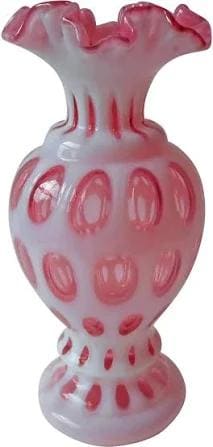Fenton Glass has been delighting collectors for over 100 years. Here’s why I fell in love with it—and why you might too.
I still remember the first time I saw a piece of Fenton Glass—at my grandmother’s home. It was a Carnival Glass bowl in deep amethyst, and it caught the light like a jewel. I didn’t even know what it was back then—I just knew it was beautiful. That little bowl sent me down the rabbit hole of vintage glass collecting, and like so many others, I quickly learned the name: Fenton.
A Family Dream That Shaped American Glass
Fenton Glass began in 1905 when two brothers, Frank and John Fenton, started decorating glass blanks in Ohio. Just two years later, in 1907, they moved their operation and built a factory in Williamstown, West Virginia—right on the banks of the mighty Ohio River. This wasn’t just any location. Being along the Ohio River was crucial. The river served as a vital transportation route for raw materials and finished glass, fueling Fenton’s growth and helping the company become one of America’s most iconic glassmakers. For over 100 years, the riverside factory on the Ohio River produced colorful, collectible glass that still captures hearts today—including mine.
Carnival Glass: The Sparkle That Started It All
In 1907, Fenton created something special: Carnival Glass. It shimmered in every color imaginable, from gold to purple to cobalt blue. It looked fancy, but it was made for everyday people. Fenton’s Carnival Glass shimmered like sunshine on glass. It was affordable, colorful, and cheerful. No wonder collectors still chase after it today.
My Favorite? Cranberry Opalescent (But Don’t Make Me Choose)
I’ve handled many beautiful Fenton pieces, but there's something about Cranberry Opalescent that always pulls me in. That soft fade from deep rose to milky white—it feels romantic, almost like glass spun from a sunset. Cranberry Opalescent—one of Fenton’s most stunning and collectible designs.
White Glass & Ruffled Edges: Classic Fenton Charm
I’m also a sucker for Fenton’s white glass—especially when it’s paired with a ruffled edge or hobnail texture. There’s something so timeless and delicate about it. This white Fenton vase with a ruffled edge is part of what makes their Silver Crest line so loved.
What Makes It Special? The Human Touch
What I love most about Fenton is the personal feel. Many pieces were hand-painted and signed by the artist. You can literally flip a vase over and see someone’s name—like a quiet little handshake across time. Those tiny details make a big difference. It’s not just glass—it’s a story.
The End of Production, But Not the End of the Story
Fenton stopped making traditional glassware in 2011. It was hard to hear, but their legacy lives on. The Fenton Gift Shop still offers limited pieces, and they’ve even created jewelry using their signature glass. It’s comforting to know the tradition continues—just in a different form. And for the rest of us? We keep collecting. We keep remembering.
Visiting the Heart of Fenton
If you ever find yourself in Williamstown, West Virginia, stop by the old Fenton factory site. Even though production ended in 2011, the spirit of the company lives on in the community. Locals still share stories of family members who worked in the factory, and many collectors make the pilgrimage just to feel close to where their favorite glass was born. The Ohio Valley—especially towns along the river like Williamstown and nearby Marietta, Ohio—was once a thriving hub for glassmaking. The river provided both transportation and inspiration. Generations of skilled artisans helped shape glass into everything from Carnival and Opalescent to delicate milk glass with ruffled edges. For me, standing near the old factory felt like walking back in time. You can almost hear the rhythmic hum of the glassblowing tools and picture the fiery furnaces glowing at dawn. It’s a reminder that every Fenton piece holds not just beauty—but a bit of American craftsmanship and history.
Make It a Vintage Road Trip: Glass Museums & Stops Near Fenton
- The Museum of American Glass in West Virginia (MAGWV) – Weston, WV About two hours from Williamstown, this museum is a treasure trove of American glass history. They have Fenton pieces, of course, but also other regional makers like Blenko and Heisey. It’s well worth the drive. magwv.org
- Marietta Antique Mall – Marietta, OH Just across the river from Williamstown, Marietta is full of charming antique shops. The Marietta Antique Mall and Twice As Nice Antiques often carry Fenton glass, along with other vintage finds.
- Blenko Glass – Milton, WV While not Fenton, Blenko is another iconic West Virginia glassmaker. You can tour their facility, watch glassblowing live, and shop their colorful creations in person.
- Fenton Gift Shop (Relocated) – Vienna, WV Though the original factory is closed, the Fenton Gift Shop relocated to Vienna, just minutes from Williamstown. They still offer limited-edition pieces, artist-signed glass, and vintage finds. fentongiftshop.com
Why I’ll Always Love Fenton
Fenton glass isn’t just something I sell or collect—it’s something I connect with. Every piece tells a story. Some are gifts. Some are heirlooms. Some were found at yard sales for $3 and are now my favorites. Whether you’re a seasoned collector or just learning the name, I promise—once you hold a piece of Fenton in your hands, you’ll understand. It’s more than glass. It’s memory. It’s beauty. It’s home.
Sources
- Fenton Art Glass Company (Archived)
- Kovels Antiques & Collectibles
- Warman’s Depression Glass Guide, Ellen T. Schroy
- Fenton Glass: The First 25 Years, William Heacock
- West Virginia Encyclopedia – Fenton
- Fenton Gift Shop

